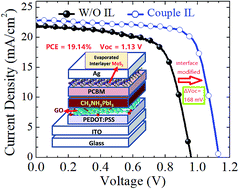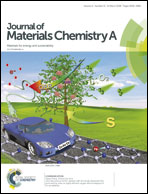Largely enhanced VOC and stability in perovskite solar cells with modified energy match by coupled 2D interlayers†
Abstract
Due to the use of a low-temperature solution process and the absence of hysteresis, PEDOT:PSS based p–i–n perovskite solar cells (PVSCs) have some obvious advantages, such as simple device technology, suitability for flexible and large size substrates, and long-term stability. However, so far their power conversion efficiency (PCE) has been much lower than that of other types of PVSCs, and in particular, they have a much lower open-circuit voltage (VOC). In this research, PEDOT:PSS based PVSCs achieve a large enhancement of VOC, PCE and device stability by using 2D materials like graphene oxide (GO) and MoS2 as interfacial layers. The CH3NH3PbI3 based PVSC with the GO and MoS2 layers shows an increased VOC from 0.962 to 1.135 V and an enhanced PCE from 14.15% to 19.14%. When a Br-doped perovskite of CH3NH3PbI2.5Br0.5 is used as the active layer, the VOC is enhanced from 1.010 to 1.176 V. The modified energy match at electrode interfaces plays a key role in the enhancement of device performance. This work indicates that 2D materials are important materials for use in interfaces of perovskite solar cells to largely enhance device performance and stability.



 Please wait while we load your content...
Please wait while we load your content...